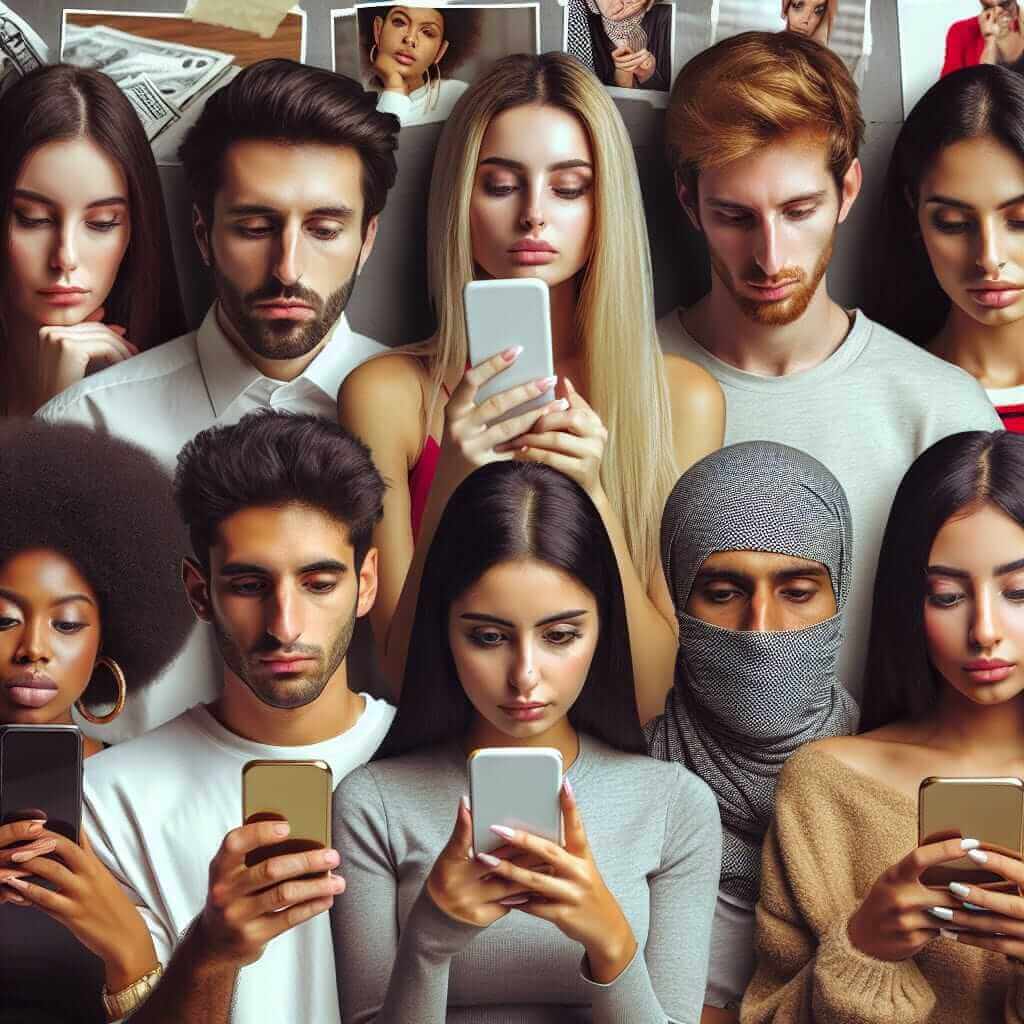The pervasive nature of social media has dramatically impacted various facets of our lives, with body image being a particularly significant one. This topic frequently surfaces in IELTS Writing Task 2, urging test-takers to critically assess the influence of these platforms on how individuals perceive their bodies.
Here are a few potential IELTS Writing Task 2 questions related to this topic:
- To what extent do you agree that social media is responsible for the pressure to attain unrealistic beauty standards?
- Social media is often blamed for negatively impacting body image, particularly among young people. What are the causes of this issue, and what measures can be taken to address it?
- Discuss the positive and negative impacts of social media on body image. What advice would you give to young people regarding their social media use?
Analyzing the Question
For this essay, let’s focus on the following question:
“Social media is often blamed for negatively impacting body image, particularly among young people. What are the causes of this issue, and what measures can be taken to address it?”
This is a classic causes and solutions essay type, requiring a well-structured response addressing both aspects of the prompt. We need to delve into the reasons behind social media’s negative impact on body image, particularly for young people, and propose viable solutions to mitigate this issue.
Model Essay
Social media has become ubiquitous, profoundly influencing how people perceive themselves and others. While it offers connectivity and information sharing, it is often criticized for negatively affecting body image, especially among young users. This essay will explore the causes of this issue and propose measures to address it.
One primary cause is the proliferation of unrealistic beauty standards perpetuated by social media. Influencers and celebrities often curate meticulously edited images and videos, showcasing seemingly flawless bodies and lifestyles. These portrayals can create a sense of inadequacy among young people, making them feel pressured to attain unattainable physical ideals. This constant exposure to digitally manipulated images can distort their self-perception, leading to negative body image and low self-esteem.
Another contributing factor is the culture of comparison fostered by social media platforms. Users, particularly young adults, are constantly bombarded with images and stories of others, often showcasing the “highlight reels” of their lives. This constant comparison with peers can fuel feelings of inadequacy and dissatisfaction with their own bodies, leading to unhealthy self-criticism and a distorted sense of self-worth.

Addressing this complex issue requires a multi-faceted approach. Media literacy programs can play a crucial role in educating young people about the curated nature of online content. By understanding how images and videos are edited and manipulated, they can develop a more critical perspective, recognizing that what they see online doesn’t always reflect reality.
Moreover, promoting body positivity and diversity in media representation is vital. Encouraging social media platforms to showcase a broader range of body types, ethnicities, and abilities can help create a more inclusive and realistic online environment. This shift in media representation can help young people feel seen and validated, fostering a healthier and more positive body image.
In conclusion, social media’s impact on body image, particularly among young people, is a significant concern. The unrealistic beauty standards and the culture of comparison it perpetuates contribute to negative self-perception and body dissatisfaction. However, through media literacy initiatives and a concerted effort to promote body positivity and diversity in media, we can mitigate these harmful effects and foster a healthier digital landscape that celebrates individuality and self-acceptance.
Word Count: 322 words
Writing Tips
- Structure: Ensure your essay adheres to a clear structure, addressing both the causes and solutions aspects of the prompt. Use cohesive devices to connect your ideas smoothly.
- Vocabulary: Employ a wide range of vocabulary related to body image, social media, and the digital world. Use synonyms to avoid repetition and demonstrate your lexical resource.
- Grammar: Maintain grammatical accuracy throughout your essay. Pay attention to sentence structure, verb tenses, and subject-verb agreement.
- Examples: Support your arguments with relevant examples to illustrate your points effectively.
- Relevance: Stay focused on the topic and avoid including irrelevant information or going off on tangents.
Vocabulary
- Ubiquitous (adj.) /juːˈbɪk.wɪ.təs/: Being or seeming to be everywhere at the same time.
- Proliferation (n.) /prəˌlɪf.əˈreɪ.ʃən/: A rapid increase in the number or amount of something.
- Perpetuate (v.) /pəˈpetʃ.u.eɪt/: To cause something to continue.
- Curate (v.) /ˈkjʊə.reɪt/: To select, organize, and present something, typically a collection of similar things.
- Inadequacy (n.) /ɪˈnæd.ə.kwə.si/: The state or quality of not being good enough.
Conclusion
Navigating the digital landscape and its impact on body image is a pressing issue, particularly for young people. By understanding the causes, implementing effective solutions, and equipping individuals with the critical thinking skills needed to navigate social media responsibly, we can foster a more positive and inclusive online environment that promotes healthy self-perception and body image. Remember to practice writing essays on similar topics to improve your ability to articulate your thoughts effectively and achieve a high band score in the IELTS writing exam.